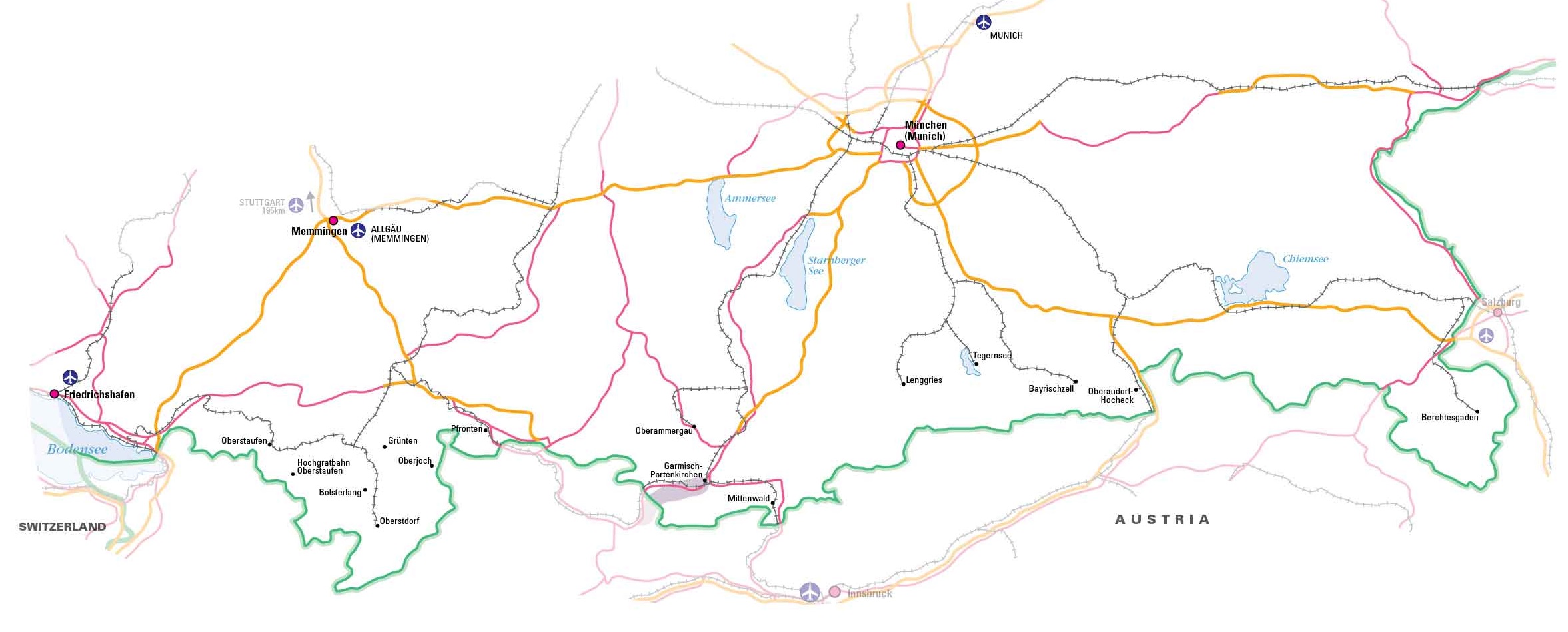Driving to the German Alps
 For a detailed road map please visit our map shop
For a detailed road map please visit our map shop
With beautiful scenery and well-maintained roads, driving through the German Alps can be a very pleasant way to start your alpine holiday. However, there are a few regulations/requirements UK drivers should be aware of:
Speed limits
There are no speed limits on many sections of the German motorways (autobahns) although the recommended maximum is 130km/h (approx 80mph). Nevertheless, contrary to popular belief, there are many motorway sections where speed limits do exist. Limits are usually prominently displayed around the main cities though you'll also see speed limit signs on other seemingly open motorway sections in the countryside. Offenders will not normally be stopped but will receive a speeding ticket by post. This may be two or even three months after the incident. Those exceeding the speed limit by more than 30km/h are likely to lose their licence for up to three months as well as incur a hefty fine. Be aware that accidents occurring at speeds of over 130km/h can result in insurance payment claims being annulled, regardless of which driver was at fault.
Off the motorways, the speed limit is 50km/h (approx 30mph) in built-up areas and 100km/h (approx 60mph) elsewhere. If you are pulling a trailer, the speed limit is 80km/h (50mph) on roads and autobahns.
Equipment
• Warning triangle. German law requires that all cars registered in Germany carry a portable red reflective triangle. If a car is stopped for any reason, the triangle must be placed 200m behind it if on the autobahn and 100m behind it on all other roads. The car’s hazard lights should also be switched on. Whilst it is not compulsory for cars resistered abroad to carry a triangle it is highly recommended as its use is compulsory in an accident or breakdown situation.
• First aid kit (recommended)
• Reflective jacket (recommended)
Seat belts and children
Seat belts must be worn at all times and there is a €30 on-the-spot fine for anyone found not to be wearing a seat belt. An exception is made for rear seat passengers in older cars where seat belts were not originally fitted. Children under 12 are not allowed to ride in the front seat of a car and must use car seats certified by the German government.
Driving and traffic signs
Only pass vehicles on the left. There's a hefty fine for passing on the right.
If you are unfortunate enough to be involved in an accident, do not leave the scene. Drivers of any vehicle involved in an accident must remain at the scene for at least 30 minutes before leaving, if alone. If you are involved in an accident with others, you must exchange personal and insurance information.
The German right of way is different to that in the UK. Unless otherwise signed, the driver coming from the right at an intersection has the right of way. Therefore, even if you are on what looks to be the major road, you may not have right of way. A yellow and white diamond-shaped sign indicates right of way.
A yield sign (red and white inverted triangle) means that you must yield the right of way. If the way is clear, you don't have to stop. However an 8-sided stop sign means that you must come to a complete stop before proceeding.
A blinking yellow light at an intersection indicates that you should stop then proceed if the intersection is clear. Many intersections have cameras and if you go through a red light, you are likely to be caught.
Traffic calming zones (Verkehrsberuhigungenzone) are indicated by a sign showing a pedestrian and a child kicking a ball and are often found in residential areas. Where these are shown, children may use the entire street and traffic must stop for pedestrians and move at no more than 7km/h.
Motorists may not pass a bus that is signalling that it is about to stop. Once the bus has stopped, you may pass but at such a slow speed that the needle on your speedometer does not register. Cars headed in the opposite direction to the bus must do the same. This is because of the danger that people, particularly children, may try to cross the street in an effort to catch the bus. If any do, you must stop and let them cross.
In line with the European average, driving is not permitted with a blood alcohol content above 0.5g per litre.
Winter driving
Driving on snow-covered roads is permitted only with the proper tyres. These may be dedicated winter tyres or all-weather tyres. Use of any other tyre may result in a fine. Check what tyres you should fit on your car before you travel.
Scenic routes
A number of themed tourist routes have been devised to link Bavaria's most important natural and cultural highlights. These include the Castle Road and the Romantic Road as well as the scenic German Alpine Road which winds for 280 miles through the Bavarian Alps from Lake Constance in the west to Königssee in the east, passing many ski resorts - more information on Bavaria’s scenic routes

